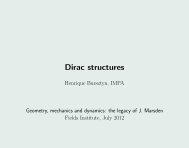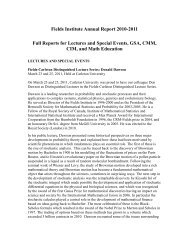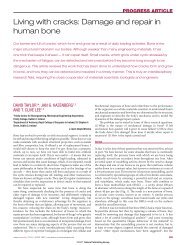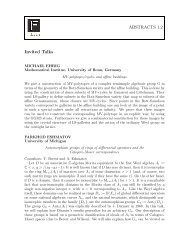The Valuation of Basket Credit Derivatives: A Copula Function ...
The Valuation of Basket Credit Derivatives: A Copula Function ...
The Valuation of Basket Credit Derivatives: A Copula Function ...
You also want an ePaper? Increase the reach of your titles
YUMPU automatically turns print PDFs into web optimized ePapers that Google loves.
<strong>The</strong> <strong>Valuation</strong> <strong>of</strong> <strong>Basket</strong> <strong>Credit</strong> <strong>Derivatives</strong>:<br />
A <strong>Copula</strong> <strong>Function</strong> Approach<br />
David X. Li<br />
Risk Management<br />
AXA Financial<br />
1290 Ave <strong>of</strong> Americas<br />
New York, NY 10104<br />
email: david.li@axacs.com<br />
Phone: 212-314-3509<br />
Toronto<br />
December 8, 2000
Outline<br />
● <strong>The</strong> Construction <strong>of</strong> <strong>Credit</strong> Curves<br />
● On Default Correlation: <strong>The</strong> Joy <strong>of</strong> <strong>Copula</strong> <strong>Function</strong>s<br />
● <strong>The</strong> <strong>Valuation</strong> <strong>of</strong> <strong>Credit</strong> Default Swaps<br />
● <strong>The</strong> <strong>Valuation</strong> <strong>of</strong> <strong>Basket</strong> <strong>Credit</strong> <strong>Derivatives</strong><br />
- First default / first loss<br />
- CBOs/CLOs
<strong>Credit</strong> Markets Are Being Transformed<br />
● Shrinking Loan Pr<strong>of</strong>it Margin<br />
● Low interest rate environment<br />
● Huge amount <strong>of</strong> investment money<br />
● Changing regulatory environment<br />
● <strong>The</strong>oretical and analytical advancements<br />
● Technology
<strong>Credit</strong> Derivative Products<br />
Total return swap<br />
Default contingent<br />
forward<br />
Corporate loans<br />
Corporate bonds<br />
Sovereign bonds/loans<br />
Structures<br />
<strong>Credit</strong> swap<br />
<strong>Credit</strong> linked note<br />
Underlying Assets<br />
Spread forward<br />
Spread option<br />
Specified loans or bonds<br />
Portfolio <strong>of</strong> loans or bonds
<strong>Credit</strong> Swap Pricing: Illustration<br />
Counterparty<br />
A<br />
Payment<br />
Zero<br />
??? bps per period<br />
<strong>Credit</strong> event<br />
No credit event<br />
Counterparty<br />
B<br />
Reference <strong>Credit</strong>: Company X<br />
Swap Tenor: 3 Years<br />
Event Payment: Par - Post Default Market Value
Bond Insurance v.s. <strong>Credit</strong> Default Swaps<br />
Bond insurance <strong>Credit</strong> Default Swaps<br />
● Player<br />
Insurance company Banking<br />
● which side <strong>of</strong> credit risk<br />
long long and short<br />
● How to price<br />
Actuarial approach based Relative pricing based<br />
on historical data asset swap spread
Default Probabilities<br />
● From Historical Data<br />
- Moody’s and S&P publish historical data<br />
● From Merton’s Option Framework<br />
- data<br />
- method to address term structure <strong>of</strong> default rates<br />
● From Market Observed <strong>Credit</strong> Spread or Asset Spread
Asset Swaps <strong>of</strong> Bonds<br />
Pay coupons<br />
and Principle<br />
Bank pay a<br />
funding cost <strong>of</strong> L<br />
Asset Swaps<br />
Funding Source<br />
Bank receives fund<br />
receive L + S<br />
Bond Holder Bank ABC<br />
Swap Counterparty<br />
Pay amount M<br />
to buy the bond<br />
Need to pay to swap counterparty if<br />
the bond issuer defaults<br />
Bank ABC<br />
Pay all cash<br />
flows promised<br />
by the bond<br />
Receive S
<strong>Credit</strong> Swap Pricing:<br />
A credit curve gives instantaneous default probabilities <strong>of</strong> a<br />
credit at any time in the future conditional on the survival at<br />
that time<br />
● Construct a discount curve, such as LIBOR<br />
● Construct a credit curve for the reference credit<br />
● Construct a credit curve for the counterparty<br />
● Calculate the NSP <strong>of</strong> the protection<br />
● Amortize the NSP into a number <strong>of</strong> years
<strong>The</strong> Characterization <strong>of</strong> Default<br />
● Define a random variable called the time-until-default to<br />
denote the survival time Pr[T < t ] = F(t)<br />
● Use survival function or hazard rate function to<br />
describe this survival time<br />
S (<br />
t ) = 1 − F ( t )<br />
h ( t ) =<br />
f ( t )<br />
= −<br />
S '(<br />
t )<br />
1 − F ( t ) S ( t )<br />
t<br />
− ∫ h ( s ) ds<br />
S ( t ) = e 0<br />
t<br />
q x = Pr[ T − t ≤ t | T > x ]<br />
t<br />
p x = 1−<br />
t<br />
q x
Constructing a <strong>Credit</strong> Curve<br />
● <strong>Valuation</strong> <strong>of</strong> Risky Bond -- Duffie and Singleton Approach<br />
● Default Treatment: Recover a fixed % R <strong>of</strong> the value just<br />
before default<br />
● One period<br />
V<br />
=<br />
≅<br />
V<br />
1-p<br />
p<br />
R<br />
1<br />
[ p + (<br />
1 − p ) R ]<br />
e<br />
−<br />
∆ t<br />
∫<br />
0<br />
e<br />
[ r ( s ) + ( 1 − R ( s ) ) h ( s ) ]<br />
−<br />
r ∆ t<br />
ds
Multiperiod<br />
● General Case<br />
V<br />
t (<br />
0 )<br />
=<br />
C1 C2 Cn<br />
...<br />
t0 t1 t2 ...<br />
tn<br />
n<br />
∑<br />
i<br />
C<br />
i<br />
⋅<br />
e<br />
−<br />
t<br />
i<br />
∫<br />
t0<br />
[ r ( s ) + ( 1−<br />
R ( s )) h ( s ) ]ds
Asset Swap Spreads<br />
Maturity<br />
Year<br />
LIBOR<br />
Yield<br />
1 5.89%<br />
2 6.13%<br />
3 6.30%<br />
4 6.40%<br />
5 6.48%<br />
7 6.62%<br />
10 6.78%<br />
Asset Swap<br />
Spread<br />
200 bp<br />
200<br />
200<br />
200<br />
200<br />
200<br />
200
An Example<br />
Maturity Coupon Spread Price<br />
1 year<br />
2 year<br />
3 year<br />
4 year<br />
5 year<br />
7 year<br />
10 year<br />
0.07<br />
0.05<br />
0.03<br />
7.89%<br />
8.13%<br />
8.30%<br />
8.40%<br />
8.48%<br />
8.62%<br />
8.78%<br />
200<br />
200<br />
200<br />
200<br />
200<br />
200<br />
200<br />
100.00<br />
100.00<br />
100.00<br />
100.00<br />
100.00<br />
100.00<br />
100.00<br />
<strong>Credit</strong> Curve B: Instantaneous Default Probability<br />
(Spread = 300 bp, Recovery Rate = 50%)<br />
0.01<br />
9-Sep-98 1-May-00 22-Dec-01 14-Aug-03 5-Apr-05 26-Nov-06 18-Jul-08 10-Mar-10 31-Oct-11
Default Correlation<br />
● What is the default correlation?<br />
● Traditional Correlation defined in the current finance<br />
literature<br />
Corr(A,B)<br />
=<br />
Pr<br />
P(A)[<br />
[A<br />
1<br />
∩<br />
−<br />
B]<br />
−<br />
P[A]<br />
P(A)]P(B)[<br />
⋅ P[B]<br />
1 − P(B)<br />
]
Problems with This Approach<br />
● One year is an arbitrary choice, useful information<br />
about the term structure <strong>of</strong> default rates could be lost<br />
● Default correlation is a time dependent variable<br />
● Need correlation over a number <strong>of</strong> years instead <strong>of</strong><br />
only one year<br />
● Estimation <strong>of</strong> default correlation has its problem<br />
Lucas Approach
Default Correlation: <strong>The</strong> Joy <strong>of</strong> <strong>Copula</strong>s<br />
● We first know the marginal distribution <strong>of</strong> survival<br />
time for each credit<br />
● We need to construct a joint distribution with given<br />
marginals and a correlation structures<br />
● <strong>Copula</strong> function in multivariate statistics can be used<br />
● <strong>The</strong> correlation parameters used in copula function<br />
can be interpreted as the asset correlation between<br />
two credits used in <strong>Credit</strong>Metrics
What is a <strong>Copula</strong> <strong>Function</strong>?<br />
● <strong>Function</strong> that join or couple multivariate distribution<br />
functions to their one-dimensional marginal<br />
distribution functions<br />
● For m uniform r. v., U1, U2, …., Um<br />
C u , u , ,<br />
u ) = Pr[ U ≤ u , U ≤ u , ,<br />
U ≤<br />
( 1 2 m<br />
1 1 2 2 m um<br />
● Suppose we have m marginal distributions with<br />
distribution function Fi<br />
( xi<br />
)<br />
● <strong>The</strong>n the following defines a multivariate distribution<br />
function<br />
F x , x , , x ) =<br />
C ( F ( x ), F ( x ), <br />
( 1 2 m<br />
1 1 2 2 , Fm<br />
( xm<br />
]<br />
))
A Few <strong>Copula</strong> <strong>Function</strong>s<br />
● Normal <strong>Copula</strong> <strong>Function</strong><br />
C ( u.<br />
v)<br />
=<br />
● Frank <strong>Copula</strong> <strong>Function</strong><br />
Φ<br />
● Mixture <strong>Copula</strong> <strong>Function</strong><br />
2<br />
( Φ<br />
−1<br />
( u<br />
),<br />
Φ<br />
1 ⎡<br />
C ( u , v)<br />
= ln ⎢1<br />
+<br />
α<br />
α ⎣ e<br />
−1<br />
( v),<br />
ρ )<br />
( αu<br />
)( αv<br />
e − 1 e − 1)<br />
⎤<br />
⎥⎦<br />
C ( u,<br />
v)<br />
=<br />
( 1 − ρ ) uv + ρ min( u,<br />
v)<br />
−<br />
1
<strong>Credit</strong> Swap Pricing:<br />
● Calculate the PV <strong>of</strong> Payment<br />
- 100 - Q(ti) if bond issuer defaults, but the seller does not<br />
- [100 - Q(ti)]Rc if both the bond issuer and the default<br />
protection seller defaults<br />
[ 100 − Q(<br />
t ] i ) Pr[<br />
R [ 100 − Q(<br />
t ) ]<br />
n ⎛<br />
ti<br />
1 < B ≤<br />
∑<br />
− τ<br />
⎜<br />
= 1 ⎝ C<br />
i Pr[ ti<br />
−1<br />
< τ<br />
● Calculate the PV <strong>of</strong> Premium<br />
● <strong>The</strong> Periodic or Level Premium X can be solved by<br />
equating the above two equations<br />
, τ<br />
, τ<br />
i B i c i<br />
∑ − n 1<br />
i=<br />
0<br />
X Pr[ τ<br />
> t , τ<br />
B<br />
i<br />
C<br />
><br />
t<br />
i<br />
t<br />
i<br />
≤<br />
t<br />
c<br />
] ⋅ D(<br />
t<br />
i<br />
><br />
)<br />
t<br />
] + ⎞<br />
•<br />
t ] ⎟<br />
≤ ⎠<br />
i<br />
D(<br />
t<br />
i<br />
)
Numerical Examples <strong>of</strong> Default Swap Pricing<br />
<strong>Credit</strong> Sw ap Va<br />
Default Correlation vs <strong>Credit</strong> Swap Value<br />
6.00<br />
5.00<br />
4.00<br />
3.00<br />
2.00<br />
1.00<br />
-<br />
-1.50 -1.00 -0.50 - 0.50 1.00 1.50<br />
Default Correlation
How do we simulate the default time?<br />
● Map obligors to countries and industries<br />
● Calculate asset correlation based on the historical<br />
data <strong>of</strong> equity indices, use <strong>Credit</strong>Manager<br />
● Simulate y1, y2, …, yn from a multivariate normal<br />
distriution with the asset correlation matrix<br />
● Transform the equity return to survival time by<br />
−<br />
1<br />
i<br />
T = F ( Φ<br />
i<br />
( Y<br />
i<br />
))
Summary <strong>of</strong> the Simulation<br />
Asset Correlation <strong>Copula</strong> <strong>Function</strong> Survival Time<br />
● Use <strong>Credit</strong>Metrics Approach to Default<br />
Correlation<br />
● Simulate correlated multivariate normal<br />
distribution with the asset correlation<br />
● Translate the multivariate normal random variable<br />
into survival times by using marginal term<br />
structure <strong>of</strong> default rates<br />
Details: <strong>Credit</strong>Metrics Monitor, May 1999
<strong>The</strong> <strong>Valuation</strong> <strong>of</strong> the First-to-Default<br />
● An Example: <strong>The</strong> contract pays $1 if the first default<br />
<strong>of</strong> 5-credit portfolio occurs during the first 2 years<br />
● We use the above approach to construct a credit<br />
curve for each credit<br />
● Using asset correlation and normal copula function<br />
we can construct a joint distribution <strong>of</strong> survival times<br />
● <strong>The</strong>n we can simulate the survival times for all 5<br />
credits
An Numerical Example<br />
Input Parameter<br />
hazard rate = 0.1,<br />
Interest rate = 0.1<br />
Asset Correlation = 0.25<br />
Value<br />
1<br />
0.9<br />
0.8<br />
0.7<br />
0.6<br />
0.5<br />
0.4<br />
0.3<br />
0.2<br />
0.1<br />
0<br />
<strong>The</strong> Value <strong>of</strong> the ith-to-default Contract<br />
0 5 10 15 20 25 30 35 40 45 50 55<br />
Number <strong>of</strong> Asset<br />
First-to-default<br />
Second-to-default<br />
Third-to-default
<strong>The</strong> Impact <strong>of</strong> Asset Correlation<br />
Price<br />
1<br />
0.9<br />
0.8<br />
0.7<br />
0.6<br />
0.5<br />
0.4<br />
0.3<br />
0.2<br />
0.1<br />
0<br />
<strong>The</strong> Price <strong>of</strong> the First-to-Default v.s. Asset<br />
Correlation<br />
0 0.5 1 1.5<br />
Asset Correlation<br />
5-asset<br />
20-asset
CBO/CLO Models:<br />
Extraction <strong>of</strong> Cash Flows from Simulation<br />
For a defaultable bond we can project the cash flow if we<br />
know when default occurs<br />
Actual Cash Flows<br />
Promised Cash Flows<br />
Default
Cash Flow Distribution<br />
● Interest Proceeds<br />
- Pass OC and IC test - payment each tranche<br />
consecutively<br />
- Fail OC and IC test - Retire principal<br />
● Principal Proceeds<br />
- Pass OC and IC test<br />
During the reinvestment period - buy additional high<br />
yield<br />
After the reinvestment period - retire principal from<br />
the top to bottom<br />
- Fail OC and IC test<br />
During the reinvestment period - flow through each<br />
tranche until tests are passed, remaining one is used<br />
to buy additional collateral assets
Flow Chart <strong>of</strong> Cash Flow Distribution<br />
Collateral<br />
at start<br />
<strong>of</strong> period<br />
<strong>Credit</strong><br />
Metrics<br />
Reduced<br />
collateral<br />
Collateral<br />
at end<br />
<strong>of</strong> period<br />
Principal<br />
prepayments<br />
Cashflow<br />
model<br />
Cashflow<br />
model<br />
Triggers<br />
Interest<br />
payments<br />
Principal<br />
payments<br />
No<br />
End?<br />
Yes
Simple cashflow CBO<br />
● Collateral pool -- total value <strong>of</strong> $100M<br />
- 80 identical assets, face value <strong>of</strong> $1.25M<br />
- one year maturity<br />
- annual coupon <strong>of</strong> L+180bp<br />
- in default, recover 40% <strong>of</strong> face value<br />
● Securitization<br />
- Senior tranche -- $90M <strong>of</strong> one year notes<br />
paying L+80bp<br />
- Equity -- $10M held as loss reserve<br />
L+80bp<br />
$90M<br />
$100M<br />
L+180bp<br />
What is the probability that the Senior notes pay their coupon?<br />
What is the return for the equity investors?<br />
How to characterize risk in general?<br />
$10M<br />
???
Collateral guidelines and ratio tests<br />
● Overcollateralization<br />
- ratio <strong>of</strong> performing collateral to par value <strong>of</strong> Senior notes<br />
- here, 100/90= 1.11<br />
● Interest coverage<br />
- ratio <strong>of</strong> collateral interest to interest on Senior notes<br />
- here, 100*(L+180bp)/90*(L+80bp)= 1.29 (assume L=5.5%)<br />
● Other guidelines on average rating, maturity, diversification<br />
● Typically, minimum ratio levels must be maintained<br />
throughout the life <strong>of</strong> the structure<br />
Ratios characterize risk generally,<br />
but for more information, we must look at default scenarios.
<strong>The</strong> best scenario -- no defaults<br />
● Assume LIBOR is 5.5%<br />
● Interest<br />
- receive 80*$1.25M*(L+180bp)=$7.30M<br />
- pay to Senior $90M*(L+80bp)=$5.67M<br />
- pay remainder ($1.63M) to Equity<br />
● Principal<br />
- receive 80*$1.25M=$100M<br />
- pay $90M to Senior notes, $10M to Equity<br />
● Yield<br />
- Senior receives the contracted L+80bp<br />
- Equity appreciates by 16.3%, or L+1080bp<br />
$90M<br />
90+5.67<br />
L+80bp<br />
$100M<br />
100+7.30<br />
$10M<br />
10+1.63<br />
L+1080bp
A moderate scenario -- two defaults<br />
● Interest<br />
- receive 78*$1.25M*(L+180bp)=$7.12M<br />
- pay to Senior $90M*(L+80bp)=$5.67M<br />
- pay remainder ($1.45M) to Equity<br />
● Principal<br />
- receive 78*$1.25M+2*40%*$1.25M=$98.5M<br />
- pay $90M to Senior notes, $8.5M to Equity<br />
● Yield<br />
- Senior receives the contracted L+80bp<br />
- Equity depreciates by 0.5%<br />
$90M<br />
90+5.67<br />
L+80bp<br />
$100M<br />
98.5+7.12<br />
$10M<br />
8.5+1.45<br />
-0.5%
At fifteen defaults, Senior investors get hit<br />
● Receive<br />
- Interest -- 65*$1.25M*(L+180bp)=$5.93M<br />
- Principal -- 65*$2M+15*40%*$2M=$88.75M<br />
● Pay<br />
- All receipts ($94.68M) to Senior<br />
- Equity receives nothing<br />
● Yield<br />
- Senior only appreciates 5.2%, or L-30bp<br />
- Equity is worthless<br />
$90M<br />
94.68<br />
L-30bp<br />
$100M<br />
88.75+5.93<br />
$10M<br />
0+0<br />
-100%
Use <strong>Credit</strong>Metrics to evaluate the likelihood <strong>of</strong> each<br />
scenario<br />
● Individual default probabilities<br />
- 1.2% for each asset, consistent with Ba rating<br />
● Correlations<br />
- assume a homogeneous portfolio; all pairs are the same<br />
- what level <strong>of</strong> correlation?<br />
Low Med Hi<br />
Asset corr. 0% 20% 50%<br />
Joint def. prob. 1.4bp 4.6bp 16.7bp<br />
● Simulation gives probabilities for scenarios<br />
# defaults 0 1 … 14 15<br />
probability 57.0% 21.6% … 3.8bp 2.6bp<br />
cum prob 57.0% 78.6% … 99.93% 99.95%
Putting the probabilities together with cashflows<br />
gives risk and return information<br />
● Senior<br />
- probability that L+80bp is not paid -- 7.2bp<br />
- conditional probability that some principal is not repaid,<br />
given that some interest is missed -- 4.5%<br />
● Equity<br />
Not very<br />
meaningful!<br />
- mean return -- L+280bp<br />
- standard deviation -- 14.0%<br />
- probability <strong>of</strong> positive (L+1080bp or L+239bp) return -- 78.6%<br />
- probability <strong>of</strong> losing more than 50% -- 78bp
Can now examine losses under stressed<br />
default rates<br />
● Senior notes ● Equity<br />
80bp<br />
60bp<br />
40bp<br />
20bp<br />
0bp<br />
Probability <strong>of</strong><br />
missed interest<br />
Cond Prob <strong>of</strong><br />
lost principal<br />
1.0% 1.5% 2.0% 2.5%<br />
20%<br />
16%<br />
12%<br />
8%<br />
4%<br />
0%<br />
85%<br />
80%<br />
75%<br />
70%<br />
65%<br />
60%<br />
Probability <strong>of</strong><br />
positive return<br />
1.0% 1.5% 2.0% 2.5%<br />
Default probability Default probability<br />
Probability <strong>of</strong><br />
losing 50%<br />
500bp<br />
400bp<br />
300bp<br />
200bp<br />
100bp<br />
0bp

















